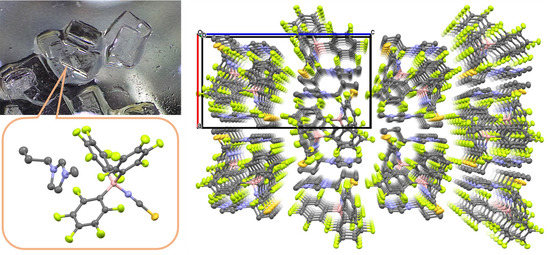Synthesis of an Adduct-Type Organic Ionic Crystal with Solid-State Ionic Conductivity from A Thiocyanate-Based Ionic Liquid and B(C6F5)3
Abstract
:1. Introduction
2. Materials and Methods
3. Results and Discussion
4. Conclusions
Author Contributions
Funding
Acknowledgments
Conflicts of Interest
References
- Kato, T.; Yoshio, M.; Ichikawa, T.; Soberats, B.; Ohno, H.; Funahashi, M. Transport of ions and electrons in nanostructured liquid crystals. Nat. Rev. Mater. 2017, 2, 17001. [Google Scholar] [CrossRef]
- Goossens, K.; Lava, K.; Bielawski, C.W.; Binnemans, K. Ionic Liquid Crystals: Versatile Materials. Chem. Rev. 2016, 116, 4643–4807. [Google Scholar] [CrossRef] [PubMed]
- Kato, T. From Nanostructured Liquid Crystals to Polymer-Based Electrolytes. Angew. Chem. Int. Ed. 2010, 49, 7847–7848. [Google Scholar] [CrossRef] [PubMed]
- Zhu, H.; MacFarlane, D.R.; Pringle, J.M.; Forsyth, M. Organic Ionic Plastic Crystals as Solid-State Electrolytes. TRECHEM 2019, 1, 126–140. [Google Scholar] [CrossRef] [Green Version]
- MacFarlane, D.R.; Forsyth, M.; Howlett, P.C.; Kar, M.; Passerini, S.; Pringle, J.M.; Ohno, H.; Watanabe, M.; Yan, F.; Zheng, W.; et al. Ionic liquids and their solid-state analogues as materials for energy generation and storage. Nat. Rev. Mater. 2016, 1, 15005. [Google Scholar] [CrossRef]
- Armel, V.; Forsyth, M.; MacFarlane, D.R.; Pringle, J.M. Organic ionic plastic crystal electrolytes; a new class of electrolyte for high efficiency solid state dye-sensitized solar cells. Energy Environ. Sci. 2011, 4, 2234–2239. [Google Scholar] [CrossRef]
- Moriya, M. Construction of nanostructures for selective lithium ion conduction using self-assembled molecular arrays in supramolecular solids. Sci. Technol. Adv. Mater. 2017, 18, 634–643. [Google Scholar] [CrossRef] [PubMed]
- Moriya, M.; Kato, D.; Hayakawa, Y.; Sakamoto, W.; Yogo, T. Crystal structure and solid state ionic conductivity of molecular crystal composed of lithium bis(trifluoromethanesulfonyl)amide and 1,2-dimethoxybenzene in a 1:1 molar ratio. Solid State Ion. 2016, 285, 29–32. [Google Scholar] [CrossRef] [Green Version]
- Moriya, M.; Nomura, K.; Sakamoto, W.; Yogo, T. Precisely controlled supramolecular ionic conduction paths and their structure-conductivity relationships for lithium ion transport. CrystEngComm 2014, 16, 10512–10518. [Google Scholar] [CrossRef]
- Moriya, M.; Kato, D.; Sakamoto, W.; Yogo, T. Structural design of ionic conduction paths in molecular crystals for selective and enhanced lithium ion conduction. Chem. Eur. J. 2013, 19, 13554–13560. [Google Scholar] [CrossRef] [PubMed]
- Moriya, M.; Kitaguchi, H.; Nishibori, E.; Sawa, H.; Sakamoto, W.; Yogo, T. Molecular ionics in supramolecular assemblies with channel structures containing lithium ions. Chem. Eur. J. 2012, 18, 15305–15309. [Google Scholar] [CrossRef] [PubMed]
- Moriya, M.; Watanabe, T.; Nabeno, S.; Sakamoto, W.; Yogo, T. Crystal structure and solid-state ionic conductivity of cyclic sulfonylamide salts with cyano-substituted quaternary ammonium cations. Chem. Lett. 2014, 43, 108–110. [Google Scholar] [CrossRef]
- Moriya, M.; Watanabe, T.; Sakamoto, W.; Yogo, T. Combination of organic cation and cyclic sulfonylamide anion exhibiting plastic crystalline behavior in a wide temperature range. RSC Adv. 2012, 2, 8502–8507. [Google Scholar] [CrossRef]
- LeBlanc, F.A.; Decken, A.; Cameron, T.S.; Passmore, J.; Rautiainen, J.M.; Whidden, T.K. Synthesis, Characterization, and Properties of Weakly Coordinating Anions Based on tris-Perfluoro-tert-Butoxyborane. Inorg. Chem. 2017, 56, 974–983. [Google Scholar] [CrossRef] [PubMed]
- Fuller, A.-M.; Mountford, A.J.; Scott, M.L.; Coles, S.J.; Horton, P.N.; Hughes, D.L.; Hursthouse, M.B.; Lancaster, S.J. Synthesis, structure, and stability of adducts between phosphide and amide anions and the Lewis acids borane, tris(pentafluorophenyl)borane, and tris(pentafluorophenyl)alane. Inorg. Chem. 2009, 48, 11474–11482. [Google Scholar] [CrossRef] [PubMed]
- Bernsdorf, A.; Brand, H.; Hellmann, R.; Köckerling, M.; Schulz, A.; Villinger, A.; Voss, K. Synthesis, structure, and bonding of weakly coordinating anions based on CN adducts. J. Am. Chem. Soc. 2009, 131, 8958–8970. [Google Scholar] [CrossRef] [PubMed]
- Zhang, Q.; Li, M.; Zhang, X.; Wu, X. The Thermodynamic Estimation and Viscosity, Electrical Conductivity Characteristics of 1-Alkyl-3-Methylimidazolium Thiocyanate Ionic Liquids. Z. Phys. Chem. 2014, 228, 851–867. [Google Scholar] [CrossRef]
- Jacobsen, H.; Berke, H.; Döring, S.; Kehr, G.; Erker, G.; Fröhlich, R.; Meyer, O. Lewis Acid Properties of Tris(pentafluorophenyl)borane. Structure and Bonding in L−B(C6F5)3 Complexes. Organometallics 1999, 18, 1724–1735. [Google Scholar] [CrossRef]






© 2019 by the authors. Licensee MDPI, Basel, Switzerland. This article is an open access article distributed under the terms and conditions of the Creative Commons Attribution (CC BY) license (http://creativecommons.org/licenses/by/4.0/).
Share and Cite
Oki, Y.; Moriya, M. Synthesis of an Adduct-Type Organic Ionic Crystal with Solid-State Ionic Conductivity from A Thiocyanate-Based Ionic Liquid and B(C6F5)3. Crystals 2019, 9, 567. https://doi.org/10.3390/cryst9110567
Oki Y, Moriya M. Synthesis of an Adduct-Type Organic Ionic Crystal with Solid-State Ionic Conductivity from A Thiocyanate-Based Ionic Liquid and B(C6F5)3. Crystals. 2019; 9(11):567. https://doi.org/10.3390/cryst9110567
Chicago/Turabian StyleOki, Yui, and Makoto Moriya. 2019. "Synthesis of an Adduct-Type Organic Ionic Crystal with Solid-State Ionic Conductivity from A Thiocyanate-Based Ionic Liquid and B(C6F5)3" Crystals 9, no. 11: 567. https://doi.org/10.3390/cryst9110567





